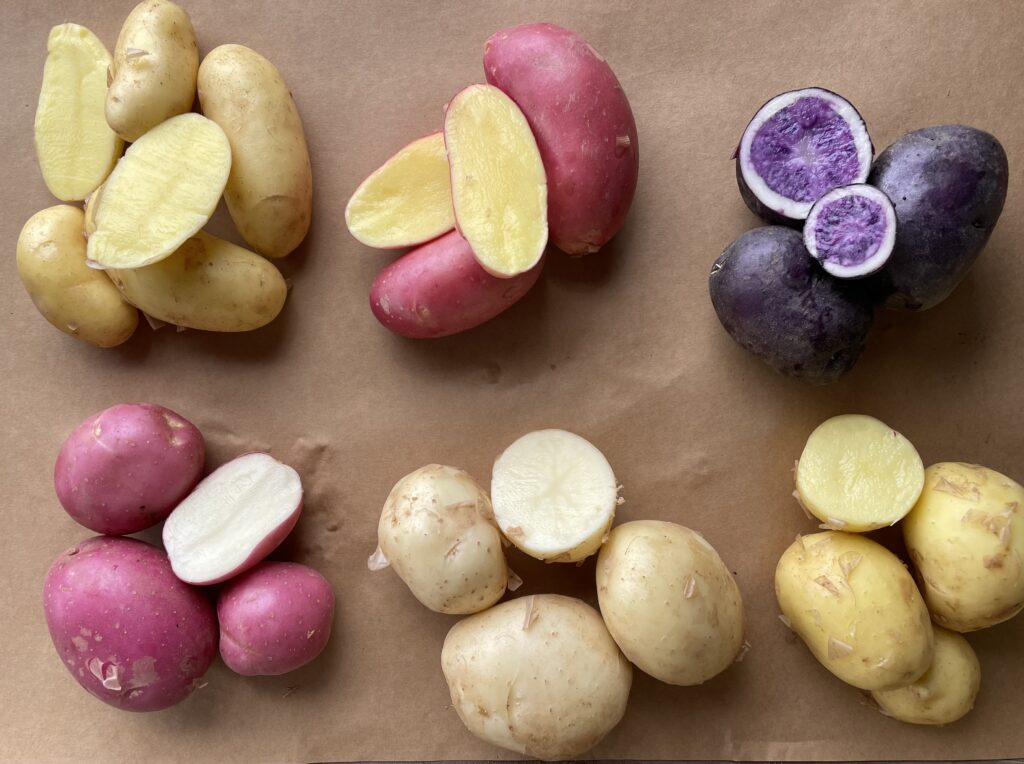We grow about 40 acres of almonds, a mix of young and old orchards, and a mix of varieties, the majority being nonpareil. We harvest in early fall, using a shaker to get the nuts off the trees. Almonds are a big deal in the Capay Valley – each year the entire Valley celebrates the Almond Festival in February, complete with a competition to crown crown an Almond Queen, corresponding with the time of year when the almond trees are in bloom.
If you have not tried our almond butter, make sure to get your hands on some this season. (But beware, it is so good that you may become addicted!) Almond butter should be refrigerated once opened but can be stored in the pantry until opening. Almonds are best stored in the refrigerator or freezer to avoid going rancid. If they last that long!



 Photo credit: Tanya Tran (
Photo credit: Tanya Tran (



 Italian Frying: Corno de toro and Jimmy Nardello are also Italian frying peppers but we grow a few varieties of much larger Italian frying peppers, such as stocky red roaster. They’ve got thick walls and a sweet juicy taste.
Italian Frying: Corno de toro and Jimmy Nardello are also Italian frying peppers but we grow a few varieties of much larger Italian frying peppers, such as stocky red roaster. They’ve got thick walls and a sweet juicy taste. Jalapeños: These peppers pack a punch! Be sure to be careful with your hands — keep them away from your eyes and mouth while chopping these peppers. They add a great spice to just about anything — we add one or two to our summer peach salsa!
Jalapeños: These peppers pack a punch! Be sure to be careful with your hands — keep them away from your eyes and mouth while chopping these peppers. They add a great spice to just about anything — we add one or two to our summer peach salsa! Jimmy Nardello: These heirloom peppers are also called sweet Italian frying peppers, great for frying, not really known for roasting. They cook quickly, sautéed in a bit of butter or oil and their flavor is amazing. They are especially good if you take time to split each pepper and remove the seeds and stem. Start them in a high heat in a heavy pan to get a bit of brown color on the skins, then cover them and lower the heat.
Jimmy Nardello: These heirloom peppers are also called sweet Italian frying peppers, great for frying, not really known for roasting. They cook quickly, sautéed in a bit of butter or oil and their flavor is amazing. They are especially good if you take time to split each pepper and remove the seeds and stem. Start them in a high heat in a heavy pan to get a bit of brown color on the skins, then cover them and lower the heat. Shishitos: Unlike the similar-looking padron pepper, shishitos aren’t hot! They are best know as an appetizer, served on their own. Heat some high quality olive oil in a frying pan, and when the oil starts to spit throw your peppers in. You want them in a single layer, otherwise they will start to steam. You want to blacken the peppers a bit on all sides until they are soft. Then toss them in sea salt and then zest a lemon over them or give them a squeeze of fresh lemon juice and toss that in too.
Shishitos: Unlike the similar-looking padron pepper, shishitos aren’t hot! They are best know as an appetizer, served on their own. Heat some high quality olive oil in a frying pan, and when the oil starts to spit throw your peppers in. You want them in a single layer, otherwise they will start to steam. You want to blacken the peppers a bit on all sides until they are soft. Then toss them in sea salt and then zest a lemon over them or give them a squeeze of fresh lemon juice and toss that in too. Pimentos: Pimento peppers aren’t just for pimento cheese! These peppers are sweet, with a thick, meaty skin. No spice, just sweet. Good for a number of cooking uses, including stuffing, and taste great raw, with or without hummus or dip.
Pimentos: Pimento peppers aren’t just for pimento cheese! These peppers are sweet, with a thick, meaty skin. No spice, just sweet. Good for a number of cooking uses, including stuffing, and taste great raw, with or without hummus or dip. Poblanos: Poblanos range from mild to hot heat levels. They are usually picked green, but if left on the plant, can turn red. Ancho peppers are dried poblanos. Poblano peppers can be used raw, they are often
Poblanos: Poblanos range from mild to hot heat levels. They are usually picked green, but if left on the plant, can turn red. Ancho peppers are dried poblanos. Poblano peppers can be used raw, they are often 